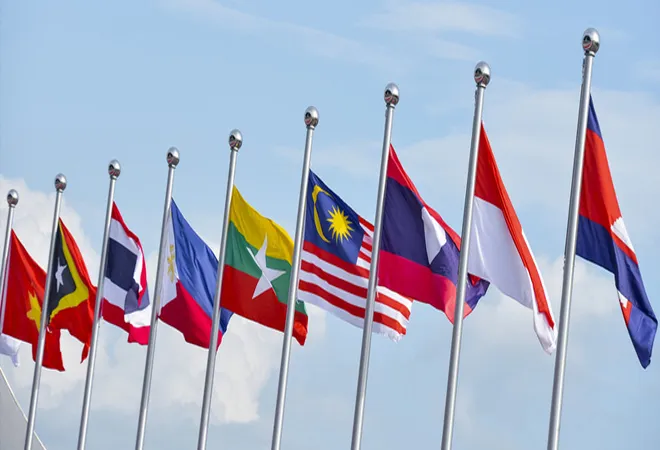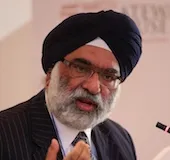
The East Asia Summit (EAS) is one of the major summits in the Indo-Pacific region. It is normally held just after the second ASEAN summit of the year where the ASEAN members engage with its dialogue partners. The ASEAN Chair also heads the EAS in acknowledgement of ASEAN’s centrality. All such regional institutions are challenged by the altering nuances of engagement with their partners. These include the difficulties in consensus-based reform and consolidation, the hiatus between implementation and expectations, and the evolving strategic environment within which they coexist.
The discussion on the creation of the East Asia Summit preceded the expansion of ASEAN to its present levels. In the 1990s, an East Asian caucus or association was first considered by Malaysia. This was to build on the Asia Pacific Economic Cooperation (APEC) established in 1989.
The discussion on the creation of the East Asia Summit preceded the expansion of ASEAN to its present levels.
The EA study group wanted to restrict EAS to the ASEAN Plus Three (APT). Malaysia and China in particular wanted a limited membership; Indonesia and Singapore amongst the ASEAN and Japan sought a wider catchment. In 2002, India elevated its partnership with ASEAN from a sectoral dialogue to a summit. India, Australia, and New Zealand were invited into the EAS in 2005. The first summit was in Kuala Lumpur on 14 December 2005. alongside the 11th ASEAN Summit and the pattern has held since then.
The China factor
Some analysts believe that China lost initial interest in the EAS because it could not head the proceedings. China preferred to lead EAS by dominating the APT, however, ASEAN turned EAS into an ASEAN-centric, not a China-led institution.
In 2011, Russia and the United States (US) were admitted into the EAS. In ASEAN’s view, this brought all the big powers including three of the P5 of the United Nations (UN), into an ASEAN-centric institution. It gave ASEAN leaders an exclusive opportunity to meet the global big powers annually. At EAS meetings, the US president was considered the main attraction. Obama attended the 2011 EAS when the US was admitted and the subsequent ones, except the 2013 summit. However, Trump avoided the EAS during his term. Russia always sent in its premier, except in 2018, when Putin participated in Singapore. China too sent in its premier while the Chinese President, Xi Jinping, would attend the APEC.
ASEAN was relieved that regional security was now not only the responsibility of the US. Russia and China as part of the EAS could chip in to maintain regional stability. The functional nature of ASEAN required this security balance. Priority areas of EAS cooperation included energy, education, finance, global health including pandemics, environment, and disaster management.
By 2012, ASEAN-China relations were strained due to Chinese belligerent behaviour in the South China Sea (SCS). This created an ASEAN crisis in 2012 under the Cambodian chairmanship. ASEAN remained adamant that the EAS should not discuss Chinese activities; they believe they could deal with China separately. A major act of imbalance in the region, the Chinese claim on the nine-dash line, was kept out by ASEAN from EAS discussions. In 2013, Xi Jinping announced in Jakarta the Belt and Road Initiative (BRI) which promised infrastructure projects in the region. While this assuaged ASEAN concerns, it created anxiety amongst other EAS partners, particularly the Quad. ASEAN’s inability to counter China now impinges upon its EAS partners. China engaged ASEAN to keep themselves insulated at the EAS and diverted attention from the ARF.
Priority areas of EAS cooperation included energy, education, finance, global health including pandemics, environment, and disaster management.
The EAS mainly dealt with functional issues like diseases, green economy, public health, and mental health amongst others and steered clear of strategic issues. This could be witnessed in EAS engagements such as the ASEAN Coordinating Centre for Humanitarian Assistance on Disaster Management (AHA Centre), which attracted EAS support. The East Asia Low Carbon Growth Partnership Dialogue through which Japan promoted a Joint Crediting Mechanism is also an EAS success. The Regional Comprehensive Economic Partnership (RCEP) was a co-EAS emergence though US and Russia were not in it and India withdrew in 2019.
The value was in the informal consultations which EAS provided. The pandemic in 2020 led to virtual summits, robbing them of their main value. The static statements delivered virtually displayed lip service but nothing much seemed to be happening.
ASEAN’s centrality under jeopardy?
ASEAN was scrambling to maintain EAS to ensure its centrality. EAS partners were wary of China leading to the acceptance of Indo-Pacific policies by Japan, India, and Australia and the re-emergence of the Quad under Biden in 2021. This was a move to outmanoeuvre ASEAN assuaging China.
In 2012, as China grabbed parts of the SCS, efforts to have EAS enunciate an Indo-Pacific policy faltered. Indonesia, India, and Russia presented draft papers to an EAS group but it came to nought, as strategic initiatives in EAS did. In 2019, ASEAN finally came up with the ASEAN Outlook for the Indo-Pacific (AOIP). It was drafted to assuage China and tell EAS partners about their serious intent. China did not object to the AoIP since it uses the term ‘Indo-Pacific’ only in the title and not in the document. The tenets of the AOIP have become the mainstay of ASEAN collaboration with partners and it seeks to bring them to the EAS for wider dissemination and acceptance and to consequently maintain its centrality.
Indonesia, India, and Russia presented draft papers to an EAS group but it came to nought, as strategic initiatives in EAS did.
EAS partners have no problem with ASEAN centrality. They are worried about ASEAN’s responsibility towards that centrality and whether it can maintain unity despite all odds. The Quad is more vocal, making ASEAN anxious about China’s reaction. ASEAN did not visualise that the Quad members were all part of the EAS and the emergence of the Quad was a reflection of the lack of efficacy of the EAS.
This is where the EAS stands in 2022, at the crossroads of the Indo-Pacific. It is the largest of the ASEAN-centric bodies where world leaders congregate, but since it's not doing very much, the value has diminished, since, over the years, EAS has been looking more at non-traditional threats including illegal fishing, humanitarian assistance, disaster relief, (HADR) migration, etc. The EAS sees rampant competition between China’s view of the region as its backyard and the US, India, Japan Australia and others wanting to promote the FOIP. This strategic rivalry becomes more severe as the BRI is sought to be challenged by nascent initiatives amongst Quad partners. Moreover, China’s vaccine diplomacy is also being challenged by the Quad’s vaccine initiative.
Even though an attempt to reform EAS was made in 2015, no programmes were implemented. Such efforts had little impact in lifting the EAS out of its set summit talk mode. No deliberate effort was made to mobilise the EAS by adding efficacy to its ‘leaders-led’ intent and managing commonalities with other ASEAN-led functional mechanisms, including the APT, ARF, ADMM-Plus and AMF. A non-ASEAN co-chair could assist in this but ASEAN remains reluctant.
Whither to?
As the architect of the EAS, ASEAN needs to realise the ‘erosion challenges’ faced by EAS. Its position “at the apex of the ASEAN-centred regional architecture” needs rejuvenation. The basis on which the EAS was created has been trespassed by geostrategic realities. While functional and economic multipolarity is being attained, there is a greater trend toward bipolarity between the US and China and Russia.
Seven ASEAN countries joined the Indo-Pacific Economic Framework announced alongside the Quad Summit in June 2022.
Can ASEAN lead the EAS into staying relevant at this time when their partners are divided and ASEAN unity itself has weakened as noticed over the attitude to Myanmar and the Ukraine crisis? For the EAS to remain meaningful ASEAN and its partners must work together to create a new sense of trust and confidence-building. This is easier said than done. China keeps dragging its feet on the code of conduct. US allies are strengthening themselves through AUKUS and Quad. The Quad has refocused itself from security to wooing ASEAN. ASEAN members are showing greater intent of engaging more countries. Seven ASEAN countries joined the Indo-Pacific Economic Framework announced alongside the Quad Summit in June 2022. ASEAN would be required to engage with all their EAS partners in a more determined manner. Their sense of responsibility towards the EAS ought to be strengthened.
Often, ASEAN as a whole cannot act in unison. It is time for ASEAN to engage other EAS partners as individual countries, Trilateral ties between India-Australia-Indonesia and India-Vietnam-Japan could help overcome US-China competition and have creative relationships. India's IPOI offers such an opportunity. Indonesia and Singapore are two ASEAN countries that engage the IPOI pillars. If Vietnam and the Philippines could also step up to working with the IPOI, it would strengthen cross-EAS. cooperation. This ASEAN plus approach by its members could strengthen ASEAN centrality and ASEAN guidance of the EAS.
The views expressed above belong to the author(s). ORF research and analyses now available on Telegram! Click here to access our curated content — blogs, longforms and interviews.




 PREV
PREV


